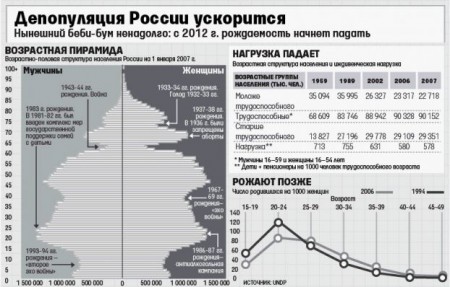Is Russia Dying Out? Or who will work in 20 years

Russia's demographic problem was called the “Russian Cross”: the birth and death lines intersect in the early 1990s, after which there were more deaths than births (see the chart on page A1). From 1992 to 2007, the difference between the number of deaths and births reached 12 million people, in 2001-2006. Russia annually lost 0.5% of the population - the whole Novgorod region or Krasnodar. In 2007, the number of births increased markedly (by 8.3%), but the cause of the baby boom is a surge in birth rates in the 1980s, says report co-author Vladimir Arkhangelsky from the Center for Population Studies at Moscow State University: children born in those years give birth .
The growth of the birth rate will last until 2012, after which the “Russian cross” will begin to expand again, predicts Anatoly Vishnevsky, head of the Center for Demography and Human Ecology, in a report at the April conference of the Higher School of Economics.
It is necessary not only to reduce the population, but also to reduce the number of able-bodied by 0.5-1 million per year. The personnel shortage by 2020 could reach 22 million people, said yesterday the deputy head of the Ministry of Health and Social Development, Alexander Safonov. Low birth rate, high mortality and reduction in the working-age population threaten the development of the country.
')
In recent years, the overall decline in population has been accompanied by a “demographic dividend” - an increase in the number of people of working age. But since 2007, a turning point has begun: there will be fewer workers, and more and more dependents (see graphs). In 2006, there were 0.6 children and a pensioner for each able-bodied, by 2025 the ratio will be 1: 0.8 and will continue to grow up to 1: 1 in 2050. This is an objective process that does not depend on social policy, Vishnevsky stresses : "People have already been born, and we know how many there will be."
The proportion of children in the total population in 1989 was 24.5%, and in 2007 - 16%; the share of the female population of 10–19 years at the beginning of 2007 was a quarter less than that of 20–29 year olds, and the number of girls 0–9 years old was 44% less. Give birth less and all later. Since 2023, the number of births may be less than 1 million per year (in 2006, almost 1.5 million). It is unlikely that a small generation born in single-child families will have a birth rate one and a half times higher than their parents by 2025, demographers doubt.
The reasons for low birth rates are material and housing problems, says Arkhangelsky, but “in reality it’s not square meters”: these difficulties serve only as a socially acceptable explanation for the reluctance to have children. Incomes need to be raised, Elizarov does not agree: in Russia, 43% of children live in families with incomes below the subsistence minimum, and in Switzerland - 4%.
In terms of life expectancy, Russia lags behind not only developed but also developing countries, says Alla Ivanova from the Central Research Institute for Organizing and Informatization of Health Care at the Ministry of Health and Social Development. In countries with similar levels of per capita GDP, men live longer by 3–11 years, women live 1–5 years. Government guidelines to achieve a life expectancy of 75 years by 2025 - “this is not God knows what, but the current level of Mexico,” says Vishnevsky. On average in the world, life expectancy increases annually by 0.22 years, while in Russia it decreases, says Yevgeny Andreyev from the Max Planck Institute for Demographic Research in Germany.
The main reasons, says Ivanova, are the low cost of human life in the eyes of the state (lack of funding for medical and social programs) and society itself (lack of responsibility for one’s health). About 200,000 people die each year for preventable reasons; two thirds of them are due to lack of medical and social assistance. Annual alcohol losses - 426,000 people, notes Alexander Nemtsov from the Moscow Research Institute of Psychiatry of the Ministry of Health and Social Development. Mortality from hypertension in Russia is 4.2 times higher than in 15 EU countries, the USA and Japan, says Andreev.
Realities demand that the authorities clarify the tasks set, the UN summarizes. A policy that proceeds from incorrect forecasts and sets unattainable goals cannot be successful, Vishnevsky stresses.
In 2001, a demographic concept was adopted, aimed at stabilizing and growing the population, experts remind, but no specific measures were taken to implement it.
Olga Kuvshinova,
Statements
Source: https://habr.com/ru/post/25167/
All Articles